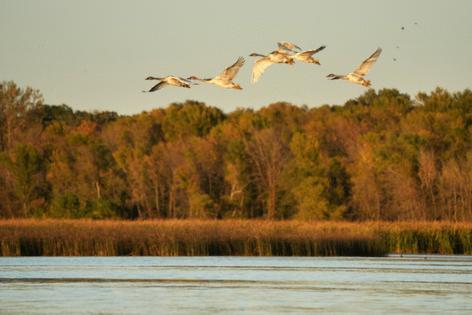Dennis Anderson: Growing trumpeter swan numbers might be too much of a good thing
Published in Outdoors
MINNEAPOLIS — They’re big. They’re beautiful. And there’s lots of them.
Perhaps too many?
Trumpeter swans are now reproducing at a rate no one predicted when 150 fragile eggs were transported to Minnesota from Alaska, beginning in 1987.
Carrol Henderson was the Department of Natural Resources non-game wildlife chief at the time, and he captured the eggs from the Minto Flats wetland complex about 35 miles west of Fairbanks, Alaska.
Weighing as much as 30 pounds as adults, with wingspans that can exceed 10 feet, Minnesota’s trumpeter swans were killed for food by early settlers. By the 1880s, few, if any, were left in the state.
“I put together a proposal to bring 50 trumpeter eggs back from Alaska in three successive years and hatch them here,” Henderson said. “We had the money to do it from the chickadee checkoff on state taxpayer forms. Northwest Airlines provided free transportation from Alaska. To keep them warm, we carried the eggs in overhead compartments in first class.”
Hatched at Carlos Avery Wildlife Management Area not far north of the Twin Cities, the young swans — cygnets — were released at just under 2 years of age in the Detroit Lakes, Minn., area.
The re-establishment followed a smaller trumpeter swan restoration effort in the early 1980s by Three Rivers Parks District, among others.
The DNR’s initial statewide trumpeter swan population goal was 15 breeding pairs, or 30 individuals.
A recent estimate suggests the number of Minnesota trumpeters is north of 51,000 — and growing.
For perspective, only 64,000 blue-winged teal — traditionally one of the state’s most abundant ducks — were counted this spring during the DNR’s annual aerial waterfowl census.
Increasing numbers of duck and goose hunters are asking whether the presence of so many trumpeters is reducing available nesting sites for other waterfowl, while also damaging wetland and shallow lake ecology.
“I was so excited the first time I saw those darn things that I called the DNR,” said Greg Lillemon, who lives on Lake Christina, near Ashby, Minn., a famed Minnesota waterfowl lake. “I was all pumped up about it. Then it got to be 25 swans, then 50 and 75 and 100, staying on the lake all summer. At night, they made so much noise they kept me up.”
Worse, Lillemon said, is that trumpeters are voracious consumers of sago pondweed tubers, a favorite food also of mallards and other dabbling ducks.
“When the lake is drawn down, as it is sometimes to kill carp and help plant growth, the bay in front of my house looks like a moonscape from all the craters the swans have hollowed out,” he said. “Then when the lake refills, because the vegetation is gone, it’s the first part of the lake that turns turbid.”
Bill Cochran of the Twin Cities also has seen trumpeter swans multiply near his northwest Minnesota duck and goose hunting camp.
“There’s now a pair on every pothole we hunt,” Cochran said. “They’re very territorial and can be aggressive. I’ve watched them circle into geese and chase the geese off.”
In 2015, trumpeter swans were tallied on 43% of state transects, or routes, biologists flew during spring waterfowl counts. By 2022, that number was 78%.
“The increase of trumpeter swans throughout much of Minnesota is obvious,” said DNR wetland wildlife group leader Bruce Davis, stationed in Bemidji. “There’s still more expansion going on as they continue to move south and west in the state. I don’t know if their density in the prairie areas will match what it is in the central and northern parts of Minnesota. Whether it does or doesn’t, there are a lot of swans.”
Unknown to DNR researchers, Davis said, is whether the state’s growing swan population adversely affects wetland and shallow lake vegetation, as Lillemon suggests. Also unknown is whether the big birds contribute to wetland and shallow lake turbidity, which inhibits plant growth.
“We’ve talked about doing research on those subjects,” Davis said. “Wisconsin is currently looking into how wild rice might be affected by trumpeter swans.”
Trumpeter swans are different than tundra swans, a smattering of which migrate through Minnesota from Canada in spring and fall.
Smaller than trumpeters, tundra swans (formerly known as whistling swans) weigh between 13 and 20 pounds, with wingspans of about 5 feet.
Tundras are hunted in North Dakota and South Dakota, among eight other states. Trumpeters, by contrast, are protected throughout North America.
“Hunters have to draw a permit by lottery to hunt tundra swans in North Dakota,” said John Palarski, North Dakota Game and Fish Department migratory game bird supervisor. “If a permit is drawn, a hunter gets only one swan.”
Increasingly, Palarski said, trumpeters are showing up in eastern North Dakota, probably spilling over from Minnesota’s growing population. Because North Dakota has so much suitable habitat for the bigger swans, “It’s not a question of if trumpeters will someday populate North Dakota, but when."
North Dakota and other states could be forced to decide whether the big birds should be hunted, along with tundras. Asking hunters to distinguish one from the other in the field, especially if flying together, would place the hunters, and wildlife enforcement officers, in untenable situations.
“For the longest time, we’ve had only tundras come through North Dakota and they stay only a short while during migration,” Palarski said. “Now that’s changing, with the appearance of more trumpeters. That’s a good question, what that holds for hunting.”
Cochran, meanwhile, warns kids not to paddleboard near trumpeter swan nests on the northeast Minnesota lake where he and his wife own a cabin.
In 2012, 37-year-old Chicago kayaker Anthony Hensley was attacked by a male trumpeter swan believed to be protecting a nest. Hensley’s kayak capsized, and the swan’s relentless assaults prevented him from surfacing and swimming to shore, and he drowned.
“We’ve had dead hen mallards float to shore at my lake cabin that I believe were killed by swans during nesting season,” Cochran said. “I’ve told kids not to go near them.”
____
©2025 The Minnesota Star Tribune. Visit at startribune.com. Distributed by Tribune Content Agency, LLC.







Comments